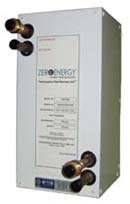
The ZEROENERGY™ system recovers heat from the air conditioning system to provide free hot water.
Very simply put, the ZEROENERGY™ System uses the waste heat from the air conditioning system to heat water for kitchen and bathrooms. This is the heat that is currently blown into the atmosphere by the a/c system’s condensing unit. Sound too good to be true? Not really. It’s a new and improved application of some basic principles of physics to an old idea called heat recovery. Inherent in the design are subtle improvements that eliminate problems like pressure drop, which occurred in older heat recovery designs.
Thomas Hebert, president and founder of Tampa’s Professional Energy Solutions, creator of the system, explained, “First of all, this isnotone of the tankless water heaters you may have heard about. Tankless water heaters still require energy - gas or electricity - to heat the water, sometimes lots of it. In fact, some homes have to enlarge their electrical service to accommodate an electric tankless water heater. And, the only energy saved is the heat normally lost through the walls of the hot water tank being replaced - an energy savings of only 8 to 12 percent.” This number is low partly because hot water tanks are better insulated these days, meaning little heat is being lost to the atmosphere, partly negating the benefit of tankless water heaters.
“This is not a solar system either,” said Hebert. “Solar systems are more expensive to install than tankless heaters, plus they require a pump to operate, are susceptible to freezing, and because of clouds and evening darkness, they only provide approximately 60 to 70 percent of the needed hot water.”
The ZEROENERGY System is only slightly more complicated than the 44-word explanation in the second paragraph. The physics are well known, but previously unused for this application: the thermosiphon effect - heat rises; and the coriolos effect - fluids tend to spin counterclockwise north of the equator. Of course, these principles are being cleverly applied, involving a number of patents owned by Hebert. But what it means to the consumer is actually free hot water flowing into the existing hot water tank. No gas or electricity is used to heat the water.
How much free hot water?
“Well, the average home’s 80-gallon hot water tank needs about 33,000 Btu of heat a day, and running a 4-ton air conditioning system 12 hours a day generates about 115,200 Btu of waste heat, more than three times what you will normally use,” said Hebert. That’s a savings of $300 to $700 per year.
The system has no moving parts, no energy-consuming pumps or controls to burn out, and it works day and night, all controlled by the existing thermostat in the hot water tank. And, with the simplicity of the design, the system should outlast both the air conditioning (or heat pump) unit and water heater by several times over. In fact, as the condensing unit runs cooler, its operating life may actually be extended. As a result, Professional Energy Solutions offers a 10-year limited warranty on the primary heat exchanger and cabinet. With its quick payback, the ZEROENERGY™ System should be popular for new construction as well as for existing homes.
Installation can be handled by any licensed HVAC contractor. For more information, visit Professional Energy Solutions’ Website at www.pesfl.com or call 813-978-3733.
Publication date:08/27/2007

Report Abusive Comment